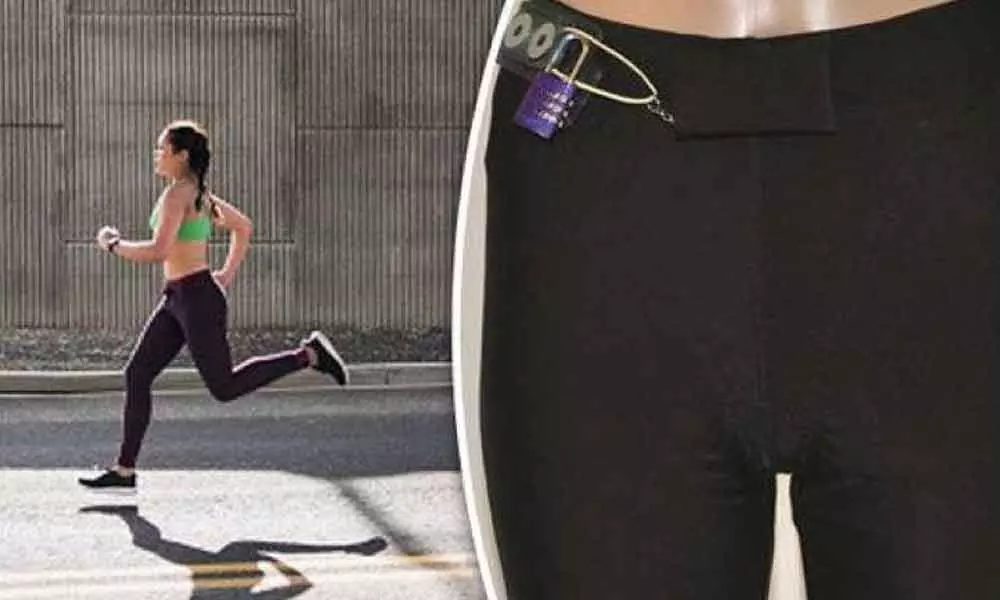Live
- GMR Airports Unveils AI-Powered Digital Twin Platform to Transform Airport Operations
- India poised to become leading maritime player: PM Modi
- Top Causes of Kidney Stones and How to Recognize Silent Symptoms
- India’s renewable energy capacity logs 14.2 pc growth at 213.7 GW
- Winter Session of Odisha Assembly adjourned sine die
- Biden calls Trump's tariff approach 'major mistake'
- After Drama Over Eknath Shinde’s Chief Minister Race, Maharashtra Cabinet Formation Faces New Tensions
- Egyptian FM, Blinken discuss recent developments in Syria
- Iran's supreme leader says Syria's developments result of US-Israeli 'plot'
- Elon Musk to Purchase $100 Million Luxury Mansion Next to Donald Trump's Mar-a-Lago, Report Reveals
Just In
Anti Rape Underwear and Devices to Protect Women from Violence


Anti-rape underwear, a fashionable vest that can jolt molesters out of their wits or a watch-like device fitted to give abusers an electric shock students from various colleges and schools in the country are channelling their outrage and anger over sexual attacks on women in the country through several futuristic innovations.
Anti-rape underwear, a fashionable vest that can jolt molesters out of their wits or a watch-like device fitted to give abusers an electric shock — students from various colleges and schools in the country are channelling their outrage and anger over sexual attacks on women in the country through several futuristic innovations.
Externally, it looks like a nightgown, ordinarily worn by women or teenage girls, but the garment is literally a power-packed GPS and sensor-enabled device capable of temporarily incapacitating assaulters off their feet by triggering a 3800 kV electric shock at the press of a button by the wearer.
"It was the pain of every woman, which triggered the idea. All the more, it was hatred against molesters and eve-teasers which led to this design," says Manisha Mohan the inventor of the "anti-rape underwear" and what she calls 'SHE' or Society Harnessing Equipment.
Apart from administering a powerful shock to the assaulter, the garment is also devised to send an alert to the Police when the sensors are activated.
"The concept of a stun gun similar to the ones used by a Policeman which can discharge electricity up to 110 volts and catch a person off-guard. The principle is to momentarily shock the person into immobility with a low-voltage pulse delivered between two electrodes,"
With the ever-increasing number of rape cases and sexual assault being reported in newspapers every day in the country, repeated efforts are being made to curb such incidents. In the recent past, several girls have taken it upon themselves to come up with ideas to prevent rape.
While most of you must have heard of self-defence tools like pepper spray, have you ever come across the term 'rape-proof underwear'?
underwear which will not only prevent rape but also help catch the rapists. A device which is equipped with a camera and a GPS. An emergency calling button has also been installed in the device. The installed GPS will help in alerting the police officers and the family about the girl's location, and a call can easily be made with just one click. The underwear will have a combination lock which will only unlock with the set passcode.
In most of the cases, the rapists are not identified, and thus, not arrested. However, in this device, the camera will capture the image of the culprit, which will help with the identification of the rapist during investigations.
Women do not need to wear the 'rape-proof underwear' all the time, and can wear it only when travelling alone.
Skin showing is a problem women face every day.
Dress codes tell us that our outfits and parts of our bodies, like shoulders, thighs and midriffs, should be sexualized. Dress codes tell us that a young man's education is more important than ours. After all, the way we as young women dress might distract them from getting an education.
Code of Conduct reinforces dress codes in order to create "positive, safe and healthy" environments, and anything that will "disrupt the education process" like hairstyles, spaghetti straps and exposed midriffs are banned.
Why are eight banned articles of clothing, such as spaghetti straps and crop tops, geared toward women while only two — saggy pants and muscle shirts — are directed to men?
Deeming that shoulders, belly buttons, bra straps and thighs create a "distracting learning environment" not only (inaccurately) implies that all teen boys "can't control themselves" and are sexual predators, but also sends the message that the education of male students is valued over that of female students.
Why should a girl wearing "tight-fitting pants" (i.e. leggings) be pulled out of class and and lose her learning time when a male who is supposedly "distracted" or aroused can't be told to control himself?
Perhaps instead of body-shaming students and suggesting that women who show skin aren't leaders or should not be respected, we should teach people that women are not sexual objects. News flash: When my bra strap falls off my shoulder, it's the result of Target's poorly constructed (but affordable) elastics and not my desire to dress "provocatively."
The controversy surrounding dress codes may just sound like another millennial complaint or the words of a girl who just wants to sport a cute outfit, but the truth is, dress-code policies run far deeper. Dress codes have the potential to groom teens to accept and perpetuate rape culture.
Victims of sexual assault often are asked "What were you wearing?" as if the only factor that plays into rape is revealing clothing. It's implying that it is the victim's responsibility to prevent assault, not the perpetrator's responsibility to restrain themselves, much like how it is our responsibility to avoid wearing "distracting clothing" but not someone else's responsibility to stop seeing women as sexual objects.
Teen Vogue's "What I was wearing when I was raped" campaign shows us that women are no safer in a baggy sweater and jeans than they are in a sundress, so why are we constantly being told to cover up?
Dress codes are less about supporting my education and more about supporting age-old social norms that discriminate against people who are different and diverse.
If less than an inch of the midsection is all it takes to be labelled as a "bad leader" or a "woman who shouldn't be respected," then something needs to change.
Three main areas of research emerged:
(1) dress used as a cue to sexual information,
(2) dress and sexual violence, and
(3) dress, sex, and objectification.
Our analyses revealed parents do invest their young children with sex-typed dress however sometimes children demand to wear such dress. Some women intentionally use dress to communicate sexual information but inferences about women who wear sexy dress can be misinterpreted and are sometimes negative. Observers link wearing a sexy dress to violence including sexual coercion, sexual harassment, sexual assault, and unwelcome groping, touching, and grabbing. Certain items of sexy dress that reveal the body have been linked to self-objectification. The fit of the items may also contribute to the body revealing the nature of clothing styles that elicit self-objectification. The use of sexual images of women and children has increased over time and viewing such images is also linked to self- and other-objectification.

© 2024 Hyderabad Media House Limited/The Hans India. All rights reserved. Powered by hocalwire.com






